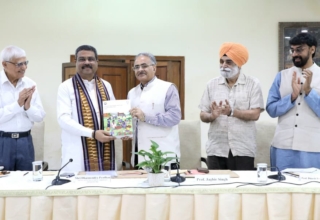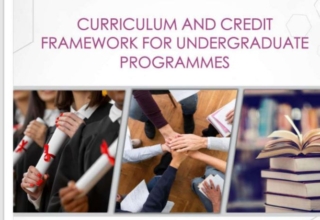
The new AAP government in Delhi has asked for amendment to no detention clause in Right to Education Act 2009 and restricting it to class III instead of present class VIII
Aam Aadmi Party (AAP), which swept the recently held Delhi Assembly election with 67 out of 70 seats and assumed power on February 14, has started off implementing its education agenda in the city. After announcing that a new set of nursery admissions guidelines for 2016 will be brought for a centralized, transparent online admission process, and asking all unaided private schools to stop taking donations for admissions in their schools, the new AAP government has written to union HRD minister to revisit Right to Education Act 2009 vis-a-vis no detention policy.as Deputy Chief Minister, Manish Sisodia, who is also the education minister, has written a letter to HRD minister, Smriti Irani in this regard and asked her to amend the law and restrict the policy of no detention till class III only. The Delhi government says the policy of not “failing” any student up to class VIII, is leading to lack of accountability among teachers in government schools. The “implementation of the no-detention policy without any prior preparation has turned out to be a mere problem and students are reaching higher classes without proper understanding and are encountering severe problems in coping with the tough syllabus,” he wrote. He said that “copy-pasting” other countries’ policies in India won’t work until a substantial change is brought in the system. “Some of us might have gone to Europe and America and would have heard about the no-detention policy. They came back and copy-pasted it here. But we need to check them in the Indian context.” Welcoming the Delhi government’s suggestion president of Delhi State Public Schools’ Management Association, RC Jain, said, “ This is a long awaited demand of the association. Due to this policy the quality of education has been degraded and there is a decline of the interest of the children towards their studies. Therefore, teachers and parents are concerned on this provision of RTE Act, 2009. The initiative of reducing no detention policy till class III is welcome. We shall be grateful to government if this clause would be removed or modified from the RTE Act, 2009 and also the association ask the government to include our association in the fee regulatory committee so that the concern of the private schools shall also be included in deciding the average fee of a school in Delhi. “ While Sisodia’s suggestion is bound to spark an intense debate around the 5th anniversary of RTE Act on April 1 and beyond, new AAP government’s education agenda implementation meanwhile is also something will be watched keenly given the peculiar issues around education in Delhi. In particular a showdown with private schools is on cards. Sources from the Delhi government have indicated that the proposed Regulation of Collection of Fees Bill on the lines of the Fees Regulation Act in Tamil Nadu, passed in 2009, may be introduced in the upcoming session of the Delhi Assembly. It proposes to constitute a high-powered committee headed by a retired judge to decide on the tuition charges levied by private schools. This may settle long-standing tussle between parents and private schools in Delhi. Earlier, last month, the directorate of education had issued an order saying that schools will have to hang a board outside their premises saying,’ charging of capitation fee for admission is illegal’ in order to raise awareness among parents. A compliance report has also been sought and any school found taking donation will be charged a fine which will be 10 times more than the amount charged from the parents. has also hinted at rationalizing and monitoring fees in private schools. The private schools lobby is naturally worried a lot. It sees their targeting by the new government and party as a negative signal for the private schools, which are perceived to be providing high quality education in comparison to government schools. According to S K Bhattacharya, chairman of the Action Committee for Unaided Schools, the real problem is that of supply and demand, which this government must address by adding pre-primary classes to government schools as Delhi High Court had asked in 2007. “The real trouble point is nursery admissions in Delhi. People want a particular school for their child, the school gets hundreds of applications against one seat and when the list is out the left outs cry foul, organize protests, etc and schools are portrayed as villains,” he adds. Endorsing the view, Ameeta M Wattal, Principal of Springdales School Pusa Road, Delhi who is also the chairperson of the influential private school assication, National Progressive School Conference (NPSC), “ The schooling should start for children at the age of 3 years in government schools, which only starts from class I, which is age +5. Between 3 & +5 years there is no space in any government schools for children to be educated. In Government schools entry classes are normally at class I level (above 5 years), hence the entire pressure of children between the ages of 3-4 years falls on the private schools which are 667-700 (approx.) in number.” According to sources, the government is also planning to set up a helpline like last year so that stakeholders can have a say. The existing grievance redressal system exists only online. The government school survey, where the infrastructure and cleanliness in schools was checked in its first 49-day stint in 2014, may start again as one of the government’s key promises is to bridge the gap between government and private schools. “The promises made are very challenging. The department has prepared a plan on what is actionable. We will be looking up to the minister for his inputs as well,” a government official reportedly said. In view of experts, it will be interesting to see how the new government transforms government schools, which it had promised. The infrastructure, quality of teachers and capacity are the real challenges. At the same time imposing regulations on private schools is not easy in the litigation culture surround education in Delhi. Last year in November, the Delhi high court quashed nursery guidelines giving higher weightage to students living in the neighbourhood of schools noting that it violated the fundamental rights of private unaided schools and private schools can be expected to fight any attempt to intrude into their functioning. “Director Education can be a regulator but not an administrative head deciding private school fee. During fee revision process, department nominee is part of the committee, so how that is the government is not aware about how the fee is hiked,” asks Bhattacharya. “As stakeholders in learning, we would like to enter the collaborative space with Government as the hunger for education has increased with inequality being phenomenal and people wanting quality education at affordable rates. The Delhi Government has integrated 25% of economically weaker sections free of cost by private schools. We are glad to be part of this endeavor as social responsibility towards the Nation. We should as Private schools continue to play a role which is philanthropic in nature and are always ready to share technologies, resources at both human and structural levels, best practices, teacher training initiatives with government schools in our neighborhood. The government can divide a city into zones and create twinning programmes, where private and government schools twin to share laboratories, create question banks, utilize each other’s teachers and have common programmes, so that children learn through each other, this will help both budget government and private schools to raise their standards and will prevent polarization between the rich and the poor, which has unfortunately happened today, “ adds Wattal citing a successful twinning project from her school some years ago. AAP in its 2015 election manifesto has made several promises which include spending at least 20% of the annual state budget on the education sector, opening of 500 new mostly secondary and senior secondary schools to be serviced by 17000 new teachers. It also promised to open 20 new colleges to overcome shortage of seats for Delhi students. Constitution of school management committees with parental representative as the vice-chairman for all schools is also on the agenda. It may be noted that there are 1,007 government schools, 1,800 recognised private schools and an estimated 2,500 unrecognised schools in Delhi. There are also 1,750 primary and pre-primary schools run by the three Delhi municipal corporations. In coming weeks and months, the education agenda, which is part of AAP’s 70-point agenda and a priority area, will unfold dramatically. But hopefully, it will also see a sincere effort at improving government school system in the city. On both counts, it will be exciting for cause of education.
Digital Gender Atlas for Girls’ Education Launched
Department of School Education and Literacy of the union ministry of HRD has launched the Digital Gender Atlas for Advancing Girls’ Education in India.The tool, which has been developed with the support of UNICEF, will help identify low performing geographic pockets for girls, particularly from marginalised groups such as scheduled castes, schedule tribes and Muslim minorities, on specific gender related education indicators. The Atlas is placed on the MHRD website and available and ready to use by States/Districts/Blocks education administrators or any other interested group. In order to plan and execute educational interventions, the purpose of the Gender Atlas is to help identify and ensure equitable education with a focus on vulnerable girls, including girls with disabilities. To ensure this is feasible, the Gender Atlas has been developed as a hands-on management tool to enable critical decisions and actions in pockets where gaps are to be met. Representation of girls in the total enrolment is 48.66% at upper primary and the percentage in secondary is 47.29%. The Atlas provides comparative analysis of individual gender related indicators over three years and that enables a visual assessment of the change and an understanding of whether some intervention introduced in a geography at a particular point in time has worked or not. It is constructed on an open source platform with an inbuilt scope of updating data by authorized persons to retain its dynamic character. The main components of the Gender Atlas are : (i) Composite Gender Ranking (ii) Trend Analysis of Gender Indicators (iii) Vulnerabilities based on educational indicators in districts with substantial tribal, schedule caste, minority population in educationally backward blocks and in left wing extremist districts, and the low sex ratio districts seleced uner Beti Bachao Beti Padhao programme. Using available Government data such as the Unified District Information System for Education (U-DISE) data (2011-2014), Census 2011 data and District Level Health Survey (DLHS) 2007-08, the Gender Atlas enables the user to navigate between geographical representation and numeric data at state, district and block levels and gives information on key indicators for girls’ education at primary, upper primary and secondary level. No primary data has been generated for the development of the atlas.
Junk food leading to rapid rise in dental diseases in children
Increasing consumption of junk food has led to a significant increase in oral diseases in children in recent years, according to dental experts who recently participated in a seminar on pediatric dentistry at SGT University, Gurgaon. Dr. Akshay Bhargav, Dean, Faculty of Dental Sciences, SGT University said: “Eating junk food in the form of burgers, pizzas, chips, French fries, cold drinks, ice creams and desserts is resulting in an epidemic of dental diseases in children, including tooth ache, cavities, decay of milk teeth, and gum problems. These food habits are very harmful for teeth. The shift from unprocessed coarse foods low in sugar to processed soft foods high in sugar, combined with high frequency of food intake, is creating havoc with oral health. Teenagers taking to smoking and drinking at an early age is also leading to tooth decay. Dental diseases, if not treated promptly, can negatively impact the overall health of a child.” According to another expert, Dr. Ashwin M Jawdekar, Professor, Paediatric & Preventive Dentistry, YMT Dental College & Hospital, Navi Mumbai: “Changes in lifestyle and food habits are triggering a spike in the incidence of dental caries, especially among children. Recent studies show overall dental caries prevalence of 55-60% in Indian population. Over-consumption of tobacco and sugar are mainly responsible for poor oral and dental health. The problem is compounded by the absence of preventive strategies for oral health, lack of uniform access to dental services, and poor budgetary allocation by the Government to ensure dental health of people. To reduce the prevalence of dental caries, a national programme of oral health is necessary which should be evidence-based, with particular focus on infants and children. It needs to leverage the existing machinery of successful public health campaigns like Pulse Polio and the manpower of dental colleges all over the country.”
Michigan State University launches India Alumni Club:
Michigan State University (MSU), USA inaugurated its’ India alumni club at a gala event at the Club, Mumbai on February 28. 3600 alumni from India have launched the MSU Alumni Club of India to further the mutual goals of education, research and collaboration between MSU and India. Claire Brender, Director, International Alumni Relations, MSU said,”Our India alumni are setting a wonderful precedent and creating this country wide network of Spartans. This is an extraordinarily committed group of individuals who are from across industries and professions working in the most important sectors and technologies, and doing great work that makes the University proud.” The website of the India club is www.msualumni.in. Having distinguished Indian alumni like Dr. Verghese Kurien who brought the White Revolution in India through Amul, MSU continues to contribute and participate in the growth and development of India, through world-class educational and research programs in Agriculture & Natural Resources, Logistics & Supply Chain Management, Packaging, Engineering and others. MSU has a vibrant world-wide alumnus network of 460,000 alumni, with 50,000 international alumni hailing from 174 countries, and organized in 25 active clubs.










